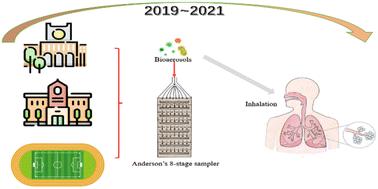当前位置:
X-MOL 学术
›
Environ. Sci.: Processes Impacts
›
论文详情
Our official English website, www.x-mol.net, welcomes your feedback! (Note: you will need to create a separate account there.)
Disruption and recovery of outdoor bioaerosols before, during, and after the COVID-19 outbreak at a campus in Central China: pathogen composition, particle size distribution, influencing factors, and exposure risk
Environmental Science: Processes & Impacts ( IF 5.5 ) Pub Date : 2024-01-23 , DOI: 10.1039/d3em00496a Yanjie Wang 1 , Haoran Zhu 1 , Song Zhang 1 , Kai Yang 1 , Yang Liu 1 , Bisheng Lai 1 , Fangfang Yu 1
Environmental Science: Processes & Impacts ( IF 5.5 ) Pub Date : 2024-01-23 , DOI: 10.1039/d3em00496a Yanjie Wang 1 , Haoran Zhu 1 , Song Zhang 1 , Kai Yang 1 , Yang Liu 1 , Bisheng Lai 1 , Fangfang Yu 1
Affiliation

|
Before (2019), during (2020), and after (2021) the COVID-19 outbreak, different response methods and measures were taken on campuses to control the spread of COVID-19 within schools. These response methods may have changed the outdoor bioaerosol characteristics, which may affect staff and student health. Therefore, we analyzed the bacterial concentrations, particle size distribution, microbial populations, exposure risks, and environmental influences of bioaerosols at a campus before, during, and after the COVID-19 outbreak. This study used eight-stage Andersen samplers to collect and analyze culturable bacteria in bioaerosols from various locations, high-throughput sequencing to analyze microbial species, principal component analysis to compare differences in samples, RDA to investigate the effects of environmental factors on bioaerosols, and hazard quotient (HQ) and BugBase to evaluate human health risks. The study findings revealed that average bacterial concentrations before, during, and after COVID-19 were 75 CFU m−3, 136 CFU m−3, and 78 CFU m−3, respectively. Moreover, the average percentage of bacteria attached to PM2.5 was 49.2%, 42.7%, and 29.9%, respectively. High-throughput sequencing revealed that species composition changed significantly during the three years of COVID-19. The proportion of Pantoea and Bacillus increased with the development of COVID-19 and these became the dominant strains after COVID-19, whereas Pseudomonas had the maximum proportion during COVID-19. Both risk assessment and BugBase phenotype prediction results indicated that the potential pathogenic risk was the highest in the outdoor environment of the campus during COVID-19 and that bioaerosol contamination was the most severe compared to the outdoor bioaerosol characteristics of the campus recovered after COVID-19.
中文翻译:

华中地区某校园在 COVID-19 爆发之前、期间和之后室外生物气溶胶的破坏和恢复:病原体组成、粒径分布、影响因素和暴露风险
在COVID-19爆发之前(2019年)、期间(2020年)和之后(2021年),校园采取了不同的应对方法和措施来控制COVID-19在学校内的传播。这些应对方法可能改变了室外生物气溶胶的特性,从而可能影响教职员工和学生的健康。因此,我们分析了 COVID-19 爆发之前、期间和之后校园内生物气溶胶的细菌浓度、粒径分布、微生物种群、暴露风险和环境影响。本研究使用八级Andersen采样器收集和分析不同地点生物气溶胶中的可培养细菌,使用高通量测序分析微生物种类,使用主成分分析比较样本差异,使用RDA研究环境因素对生物气溶胶的影响,以及危害商 (HQ) 和 BugBase 来评估人类健康风险。研究结果显示,COVID-19之前、期间和之后的平均细菌浓度分别为75 CFU m −3、136 CFU m −3和78 CFU m −3。此外,PM 2.5上附着的细菌平均百分比分别为49.2%、42.7%和29.9%。高通量测序显示,在 COVID-19 的三年期间,物种组成发生了显着变化。随着COVID-19的发展,泛菌属和芽孢杆菌属的比例逐渐增加,成为COVID-19后的优势菌株,而假单胞菌属在COVID-19期间比例最大。风险评估和BugBase表型预测结果均表明,与COVID-19后恢复的校园室外生物气溶胶特征相比,COVID-19期间校园室外环境的潜在致病风险最高,生物气溶胶污染最严重。
更新日期:2024-01-23
中文翻译:

华中地区某校园在 COVID-19 爆发之前、期间和之后室外生物气溶胶的破坏和恢复:病原体组成、粒径分布、影响因素和暴露风险
在COVID-19爆发之前(2019年)、期间(2020年)和之后(2021年),校园采取了不同的应对方法和措施来控制COVID-19在学校内的传播。这些应对方法可能改变了室外生物气溶胶的特性,从而可能影响教职员工和学生的健康。因此,我们分析了 COVID-19 爆发之前、期间和之后校园内生物气溶胶的细菌浓度、粒径分布、微生物种群、暴露风险和环境影响。本研究使用八级Andersen采样器收集和分析不同地点生物气溶胶中的可培养细菌,使用高通量测序分析微生物种类,使用主成分分析比较样本差异,使用RDA研究环境因素对生物气溶胶的影响,以及危害商 (HQ) 和 BugBase 来评估人类健康风险。研究结果显示,COVID-19之前、期间和之后的平均细菌浓度分别为75 CFU m −3、136 CFU m −3和78 CFU m −3。此外,PM 2.5上附着的细菌平均百分比分别为49.2%、42.7%和29.9%。高通量测序显示,在 COVID-19 的三年期间,物种组成发生了显着变化。随着COVID-19的发展,泛菌属和芽孢杆菌属的比例逐渐增加,成为COVID-19后的优势菌株,而假单胞菌属在COVID-19期间比例最大。风险评估和BugBase表型预测结果均表明,与COVID-19后恢复的校园室外生物气溶胶特征相比,COVID-19期间校园室外环境的潜在致病风险最高,生物气溶胶污染最严重。



























 京公网安备 11010802027423号
京公网安备 11010802027423号